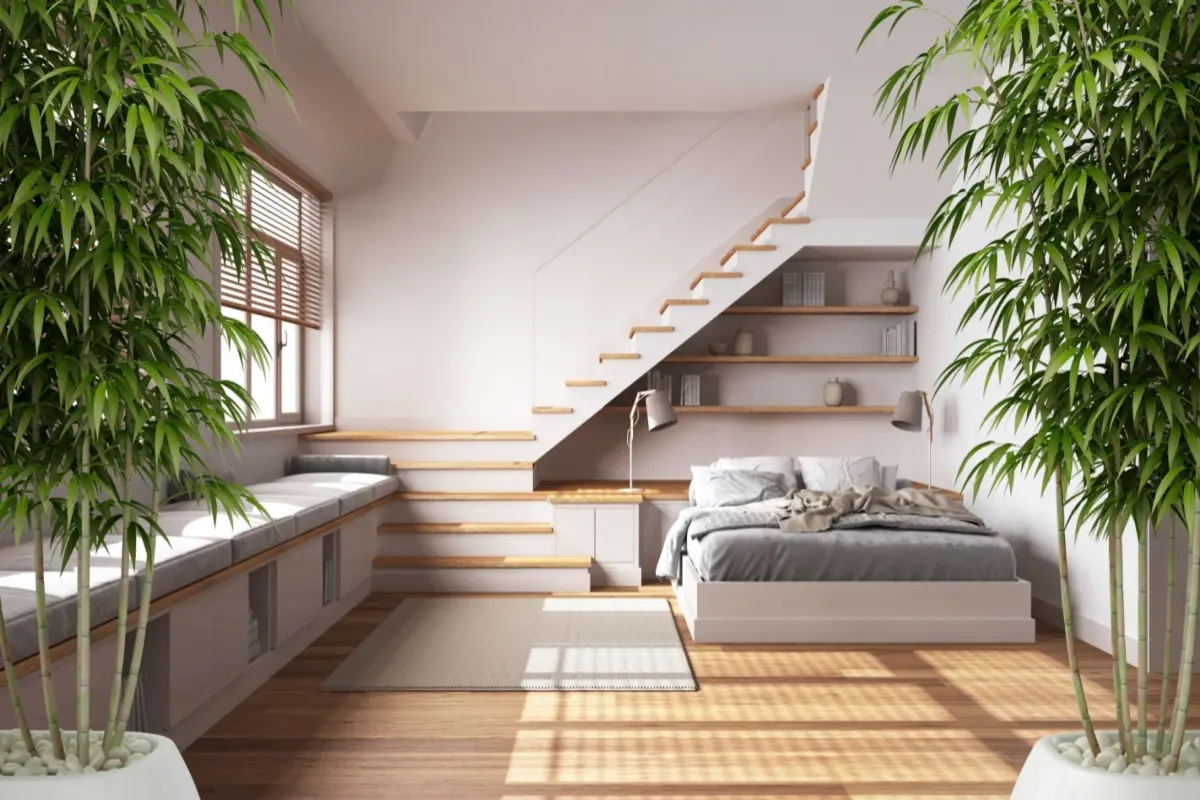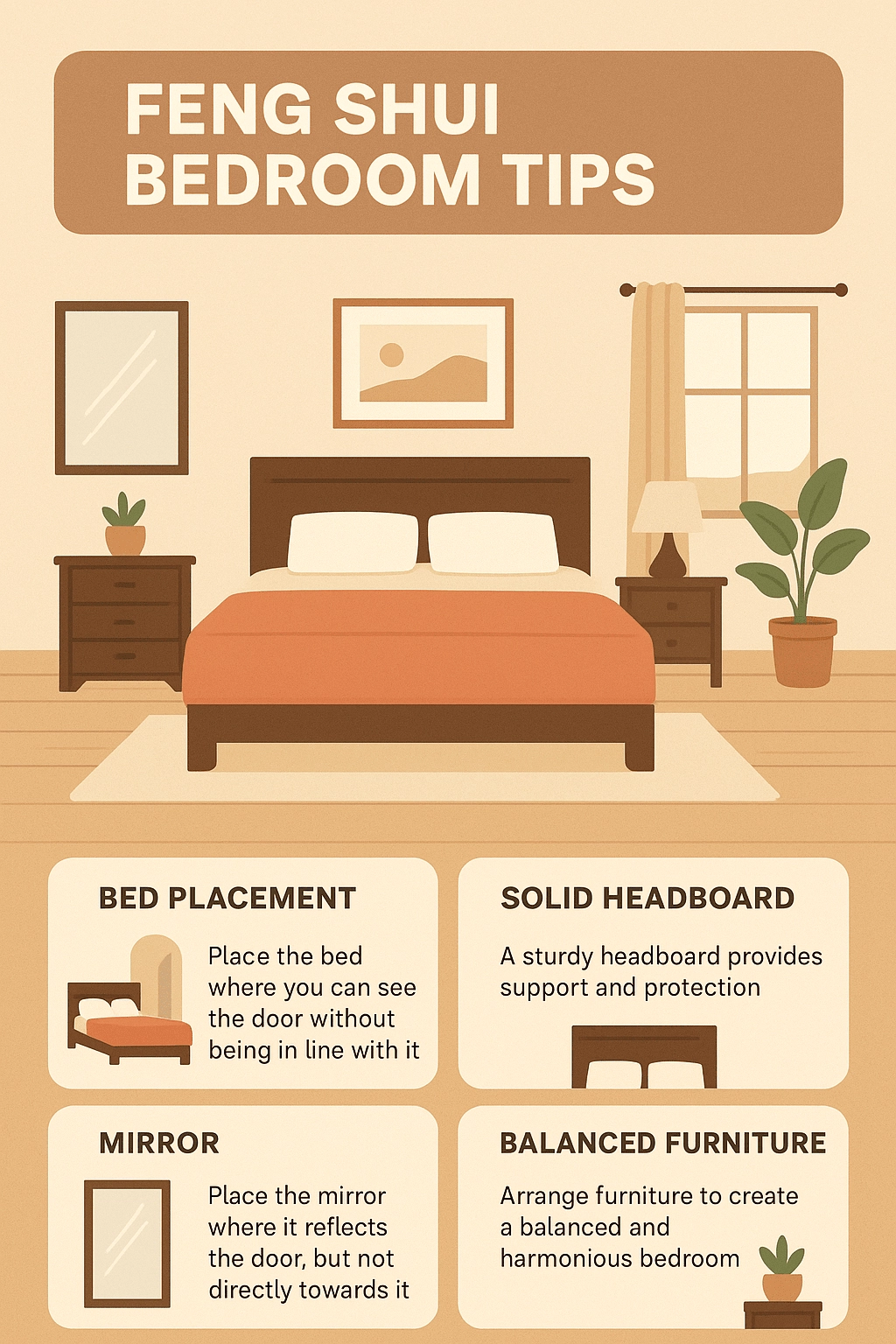Creating a peaceful and restful bedroom begins with thoughtful design. Whether or not you fully believe in feng shui, its principles offer practical ways to design a space that supports better sleep, reduces stress, and feels more balanced.
Feng shui (pronounced “fung shway”) is an ancient Chinese practice that focuses on how the arrangement of a room affects its energy flow. The term itself means “wind and water,” two natural forces associated with movement and balance. At its core, Feng shui is about directing vital life energy — called “chi” — so it moves smoothly through a space rather than getting blocked.

In simpler terms, bedroom feng shui is about creating a layout that feels safe, uncluttered, and restorative — all key ingredients for better sleep. Feng shui principles suggest that the layout and design of a space have a direct impact on sleep quality and emotional balance.
Practicing bedroom feng shui is about shaping the space where your body and mind recover each night. Here’s why it matters:
Transforming your bedroom with feng shui doesn’t require a complete overhaul. Most changes are simple adjustments that focus on comfort, balance, and flow, not a total redesign. Below are seven practical steps to bring calming energy into your bedroom — from bed placement and color choices to clearing distractions and creating harmony.

The placement of your bed is one of the most important factors in creating a bedroom that promotes restful sleep and positive energy. In feng shui, the ideal position allows you to see the door from the bed without being directly in line with it.
Being in a direct line with the door, sometimes called the “corpse” or “coffin” position, can make your subconscious feel exposed, draining energy and preventing deep rest. If your room leaves no other option, you can soften this effect by placing a tall piece of furniture at the foot of the bed or adding a round rug between the bed and the doorway to deflect energy.
Avoid placing the bed beneath a window, as this can leave your subconscious on alert, making it harder to achieve restorative sleep.
Finally, ensure that there’s open space on either side of the bed to allow energy—or chi—to flow freely. Even minor adjustments, such as angling the bed slightly or adding reflective surfaces that highlight the door, can transform your bedroom from a simple sleeping space into a sanctuary that fosters calm, security, and balanced energy.
In feng shui rooms, a sturdy bed frame and headboard provide both physical and symbolic support. In practical terms, a firm frame and headboard serve the same purpose, preventing the minor disturbances caused by a shaky bed. Wobbly or broken frames can cause micro-movements that interrupt deep sleep.
In feng shui, the area beneath your bed is considered part of your sleeping environment. When it’s filled with storage, energy can stagnate and create a sense of heaviness while you rest. Research also suggests that visible or hidden clutter in the bedroom is linked to increased stress and decreased sleep quality.
Ideally, this space should remain open to allow both air and energy to move freely. If you live in a small home and must use it for storage, keep items minimal and well-organized. Avoid sharp or heavy items, which feng shui considers “energetically disruptive.”
Aim for symmetry and balance in your layout to create a harmonious atmosphere and ensure chi energy flows evenly throughout the room. In practice, this could mean having equal space on both sides of the bed and using pairs of furnishings.
For example, place matching nightstands (with similar lamps) on either side of your bed to anchor it. Feng shui experts say that symmetric pairs help establish harmony and a sense of equality.
The colors and materials in your bedroom should foster tranquility. Feng shui recommends sticking to calming color palettes for walls, bedding, and decor.
Neutral and soft tones — such as gentle blues, greens, warm whites, beige, or pale, earthy hues — help quiet the mind, whereas bright or fiery colors can be too stimulating for a restful space. If you love bold colors, incorporate them sparingly as accents or opt for muted shades that aren’t overwhelming.
Along with color, natural textures and materials can help create a feng shui bedroom. Use cotton or linen bed sheets, plush wool or jute rugs, and other natural-inspired materials to bring a grounded, cozy feel to the room.
What is bad feng shui for bedrooms? Electronics. Televisions, laptops, and phones create constant stimulation and electromagnetic fields in a space meant for rest. Blue light from these screens delays the release of melatonin, making it harder to fall asleep.
For proper bedroom feng shui, remove screens entirely. At the very least, dim the screens and switch them off an hour before bed. Also, swapping bright overhead lights for warm bedside lamps or dimmable bulbs.
Feng shui rooms are built with intention. In the bedroom, that means surrounding yourself with items that bring a sense of calmness and connection. Choose items that invite softness and partnership:
Chi moves with the air, so fresh ventilation improves bedroom feng shui. Stale air leads to stagnant energy and a dull atmosphere. Open windows regularly, invest in an air purifier if needed, and consider a few low-maintenance plants to keep the energy vibrant. Clear pathways around the bed also matter, as crowded layouts block both airflow and circulation.
Achieving bedroom feng shui is really about creating a place that feels calm and supportive. Small changes — where you place the bed, how much light you let in, or what you choose to display — can shift the energy of the whole room. If your updates are part of a larger renovation or home remodel, home remodel financing can help make those improvements more manageable. A well-designed space pays you back every night with better rest.